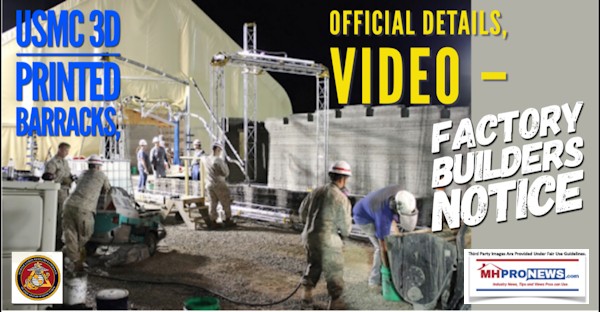
MARINE CORPS BASE QUANTICO, VA. – “The Marine Corps is leading the way in employing advanced technologies and robotic construction,” said Kaitlin Kelly, MCSC Office of Public Affairs and Communication.
“Earlier this month,” per their release, “the Additive Manufacturing Team at Marine Corps Systems Command teamed up with Marines from I Marine Expeditionary Force to operate the world’s largest concrete 3D printer at the U.S. Army Engineer Research and Development Center in Champaign, Illinois. As a joint effort between the Marine Corps, Army and Navy Seabees, an expeditionary concrete 3D printer was used to print a 500-square-foot barracks hut in 40 hours.”
“The Marine Corps is currently staffing a deliberate urgent needs statement and concept of employment for this technology. The results of the field user evaluation will inform future requirements to give the Corps a concrete construction additive manufacturing program of record,” Kelly said.
“This exercise had never been done before,” said Capt. Matthew Friedell, AM project officer in MCSC’s Operations and Programs/G-3. “People have printed buildings and large structures, but they haven’t done it onsite and all at once. This is the first-in-the-world, onsite continuous concrete print.”
The team reportedly started with a computer-aided design model on a 10-year old computer, concrete and a 3D printer. Once they hit ‘print,’ the concrete was pushed through the print head and layered repeatedly to build the walls. In total, the process took 40 hours because Marines had to monitor progress and continually fill the printer with concrete.
But Friedell said that he thinks if there was a robot to do the mixing and pumping, the building could easily be created in one day.
“In 2016, the commandant said robots should be doing everything that is dull, dangerous and dirty, and a construction site on the battlefield is all of those things,” Friedell said.
This raises issues about automation previously reported in MHProNews, on both modular and HUD Code manufactured housing building.
Billion Dollar Startup Modular Builder, Using Robotics, Could Soon Rival Clayton Homes’ Total Sales
See the linked articles, above, below and in the related reports.
The ability to build structures and bases while putting fewer Marines in danger would be a significant accomplishment, Friedell said.
“In active or simulated combat environments, we don’t want Marines out there swinging hammers and holding plywood up,” said Friedell. “Having a concrete printer that can make buildings on demand is a huge advantage for Marines operating down range.”
The USMC says it normally takes 10 Marines five days to construct a barracks hut out of wood.
With this 3D FUE, the Marine Corps proved four Marines with a concrete printer can build a strong structure in less than two days.
Ideally, said Kelly, the Corps’ use of concrete printers will span the full range of military operations, from combat environments to humanitarian aid and disaster relief missions.
As the first military services on site in natural disasters, the Navy and Marine Corps are great at providing food and water, but struggle to provide shelter, said Friedell. In many locations, cement is easier to acquire than wood.
During humanitarian or disaster relief missions, Marines could safely and quickly print houses, schools and community buildings to replace those destroyed.
That line above is one that should cause a laser focus on this topic by manufactured and modular home professionals who are disaster housing focused. And that’s just one of several levels that factory-home builders should be responding to promptly, by addressing the issues that hold manufactured homes back. See the related reports, linked below.
“This capability would enable a great partnership with the local community because it is low cost, easy to use, and robotics could print the buildings,” Friedell said. “We can bring forward better structures, houses and forward operating bases with less manpower and fewer Marines in harm’s way.”
The AM Team plans to conduct further testing and wants to get the capability into the hands of more Marines to inform future requirements for cutting-edge technology and autonomous systems, according to Kelly.
“Our future operating environment is going to be very kinetic and dangerous because we don’t necessarily know what we’re going into,” said Friedell. “The more we can pull Marines out of those potentially dangerous situations—whether it’s active combat or natural disaster—and place robotics there instead, it helps us accomplish the mission more efficiently.”
Factory home builder? This is your latest wake up call. That’s “News through the lens of manufactured homes, and factory-built housing” © – where “We Provide, You Decide.” © ## (News, analysis, and commentary.)
(Third party images, and content are provided under fair use guidelines.)
1) To sign up in seconds for our MH Industry leading emailed news updates, click here.

2) To provide a News Tips and/or Commentary, click the link to the left. Please note if comments are on-or-off the record, thank you.
3) Marketing, Web, Video, Consulting, Recruiting and Training Resources

Related Reports:
Power & Profit$ from Factual Sales & Marketing, Monday Morning Manufactured Housing Meeting – Part 1
